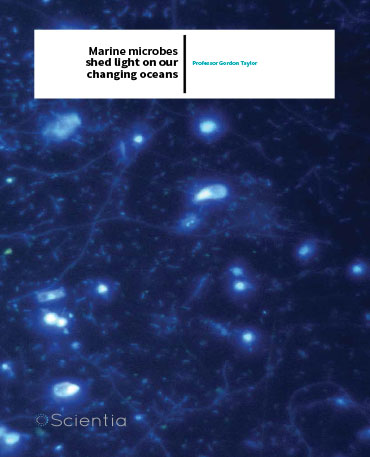Professor Gordon Taylor – Marine Microbes Shed Light On Our Changing Oceans
Gazing into the planet’s past
Virtually every modern animal living on Earth today requires free oxygen to complete its respiratory metabolism – but this has not always been the case for all organisms in our evolutionary past. The planet’s ancient history was dominated by oceanic waters devoid of dissolved oxygen, where only microbial life could thrive. As time passed, most marine habitats acquired higher levels of oxygen, as a direct result of photosynthetic microorganisms splitting water molecules and releasing free oxygen. Microscopic life forms living in the oceans are an integral part of the chemical and biological cycles of the areas they inhabit by exchanging chemicals with the environment or using the chemicals present in their surroundings.
In order to understand the ocean ecosystems and their health, Professor Gordon Taylor’s research explores the way in which microbes use and exchange chemicals with the environment, with a focus on what happens at the interfaces between habitats. Interfaces are the boundaries between different biotic regimes, places where alien worlds come in contact with each other. In many regions, oxygenated oceanic waters gradually make way for waters with lower oxygen concentration at depth called hypoxic waters, and those depths with virtually no oxygen content are called anoxic waters. The Cariaco Basin, a veritable window into the planet’s past, is the largest oceanic habitat in the world that is permanently anoxic. This basin is the target of Professor Taylor’s investigations due to its uniqueness and its potential to offer data regarding how microbes mediate the cycling of elements essential for life on Earth in large amounts, such as carbon, nitrogen and sulphur.
‘How the antifreeze glycoproteins, as well as other antifreeze proteins, evolved into functional antifreeze molecules is of much interest to evolutionary biologists’
Portrait of an oceanographer
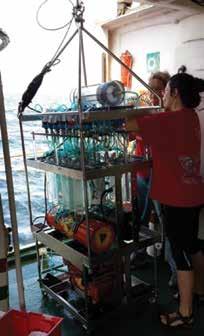 Today, Professor Taylor is a microbiological oceanographer at Stony Brook University specialising in biogeochemistry, microbial ecology, hypoxic and anoxic regimes, processes occurring at interfaces between marine habitats, and climate change. Throughout his career, his research has been funded multiple times by the National Science Foundation, which also recently enabled him to found the NAno- RAMAN Molecular Imaging Laboratory (NARMIL) in 2014. The Confocal Raman Microspectrometer and Atomic Force Microscope within this facility provide the means for his group to better understand the biogeochemical roles of specific microorganisms cell-by-cell. (visit: http://you.stonybrook.edu/nanoraman/). Furthermore, the equipment in this lab supports a wide variety of research in the fields of marine, atmospheric, environmental, biological, chemical and materials sciences. Professor Taylor is an honoured member of the Association for the Sciences of Limnology and Oceanography, and a member of the American Society for Microbiology, the American Geophysical Union, and the International Society for Microbial Ecology. He is on the editorial board of four important journals including Limnology & Oceanography: Methods and is an active reviewer for 32 other scientific publications and 14 domestic and international funding agencies. Among his professorial activities, he has served on the doctoral and master’s thesis committees of more than 70 students and taught courses in oceanography and marine microbiology. Professor Taylor has participated in more than 80 research cruises and expeditions and led 37 cruises himself. The most recent cruises centred on Three Domain MetaOmics Study of the Cariaco Basin, in Venezuela.
Today, Professor Taylor is a microbiological oceanographer at Stony Brook University specialising in biogeochemistry, microbial ecology, hypoxic and anoxic regimes, processes occurring at interfaces between marine habitats, and climate change. Throughout his career, his research has been funded multiple times by the National Science Foundation, which also recently enabled him to found the NAno- RAMAN Molecular Imaging Laboratory (NARMIL) in 2014. The Confocal Raman Microspectrometer and Atomic Force Microscope within this facility provide the means for his group to better understand the biogeochemical roles of specific microorganisms cell-by-cell. (visit: http://you.stonybrook.edu/nanoraman/). Furthermore, the equipment in this lab supports a wide variety of research in the fields of marine, atmospheric, environmental, biological, chemical and materials sciences. Professor Taylor is an honoured member of the Association for the Sciences of Limnology and Oceanography, and a member of the American Society for Microbiology, the American Geophysical Union, and the International Society for Microbial Ecology. He is on the editorial board of four important journals including Limnology & Oceanography: Methods and is an active reviewer for 32 other scientific publications and 14 domestic and international funding agencies. Among his professorial activities, he has served on the doctoral and master’s thesis committees of more than 70 students and taught courses in oceanography and marine microbiology. Professor Taylor has participated in more than 80 research cruises and expeditions and led 37 cruises himself. The most recent cruises centred on Three Domain MetaOmics Study of the Cariaco Basin, in Venezuela.
Professor Taylor tells us what motivated him to pursue a career in this field. ‘Ever since childhood, I’ve always been curious about how things work and how various components interrelate, whether they were mechanical objects or in the natural world. I whiled away my youth taking machines apart and reassembling them, building playthings from scrap yard junk, or making interesting and sometimes dangerous concoctions with my chemistry set,’ he explains. ‘But my real passion was to comb the local fields, forests, riverbanks, and lake shores of rural upstate New York for reptiles and amphibians that I could take home as pets. I kept detailed notebooks on these animals and their Mesozoic predecessors.’
By the end of his undergraduate studies, marine ecosystems held Professor Taylor in their thrall. ‘I wanted to know everything about them and how they supported such diverse and fascinating life forms,’ he tells us. ‘When I began my graduate studies, microbiological oceanography was in its infancy with so many unanswered questions and challenges. The most basic and foremost of these challenges was and still is identifying marine microorganisms and their respective ecological roles. For example, to this day the identities and roles of more than 90% of all marine microbes are unknown, largely because most species elude laboratory study by refusing to grow in culture. Advances in genetic sequencing over the last two decades, however, have somewhat diminished the microbiologists’ cultivation imperative and catapulted the field forward. In the early 1990s, my lab studied the role of marine microbes in generating seasonal hypoxia-anoxia in the nearby Long Island Sound. This led to my involvement in a project to study the world’s largest permanently anoxic marine basin, the Cariaco Basin, with my colleague, Professor Mary Scranton. One of many reasons that this system is fascinating to me is because it offers a window into Earth’s ancient past when the entire ocean was anoxic and all life was microbial. This ocean biogeochemical time-series program continues to be a major research focus for us. We have explored time and depth-dependent variations in water column structure and in chemical and microbiological processes for the last 21 years. To better understand variations in community composition and capabilities and ecosystem function, we have teamed up with several molecular microbiologists over the years.’
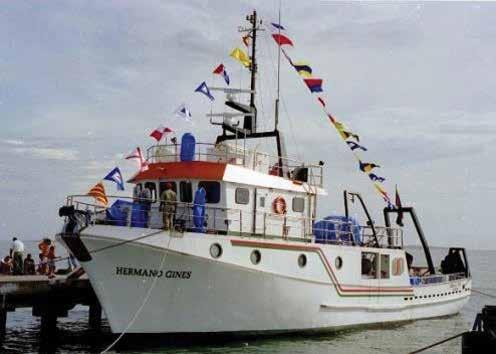
Venezuelan research vessel supporting the Cariaco Basin Ocean Time Series Program
Typical marine water columns are divided into multiple layers, each with its own biological community adapted to the surrounding chemistry and oxygen levels. Global warming is causing major changes in these habitats by amplifying the density differences between layers, decreasing the penetration depth of oxygen, and affecting the solubility of gases in water. Consequently, scientists have noticed that the regions depleted of oxygen are expanding, and therefore the ocean’s global balance of carbon, oxygen, nitrogen and sulphur is shifting. As new nutrients pour into the coastal ocean from the land – a phenomenon known as eutrophication – the so-called dead zones expand throughout nearshore regions and estuaries, impacting fauna occupying these waters and the sea floor. We should recall that this is the case because oxygen levels generally decrease with depth, and depending on the affected region, the intensity and duration of oxygen depletion varies from seasonal hypoxia to permanent anoxia. Eutrophication leads to the proliferation of algae, some of which produce harmful toxins. Moreover, excessive algal populations promote oxygen depletion. ‘In extreme cases, this chain of events leads to anoxic waters that may produce hydrogen sulfide which is toxic to most animals,’ Professor Taylor warns. Lack of oxygen leads to an entire chain of consequences. Aside from being harmful to animal life, it impacts the way that essential minerals are cycled. An example provided by Professor Taylor is that ‘loss of biologically available nitrogen is accelerated in oxygen minimum zones (OMZs) found along the eastern margins of the Pacific, Atlantic and Indian Oceans and other oxygen-depleted bodies of water. Without a compensating mechanism to replenish bioavailable nitrogen, expanding zones of oxygen depletion imply less nutrition to support plankton production in future oceans.’
This is one of Professor Taylor’s reasons for studying the Cariaco Basin. The basin acts as a natural laboratory, allowing researchers to gain insight into the microbiological and biogeochemical processes in the transition zones between oxygenated and deoxygenated waters. Conveniently, it is a single system where the whole range of oxygen conditions are available for study. ‘What we learn here informs us about how oxygen-depleted water columns elsewhere currently function and how they might function in the future as deoxygenation progresses.’ he explains. ‘Furthermore, the CARIACO Ocean Time-series program has provided monthly data on physical, chemical, biological and meteorological conditions since late 1995. This outstanding database provides a unique and very important context to facilitate understanding our molecular results on community composition, functional genes present and gene expression.’
Despite the wealth of knowledge researchers have already gathered, fundamental questions still persist about life forms feeding on inorganic and organic chemicals and living without oxygen, especially how they cycle nutrients present in the water. Although DNA and RNA sequencing technologies have enabled scientists to acquire an understanding of the genetic diversity and classification of microbes in nature, these technologies do not adequately capture the functional dynamics of microbial communities present in any given environment. Thus, there is more to learn about potential and realized capabilities of marine microbes. Their functional diversity and redundancy and their responses to chemical and physical changes in their ecosystems are still poorly understood. A particularly interesting part of Professor Taylor’s research aims to find out how microbes adapt to oxygen depletion by studying their behaviour in the context of geochemical gradients in their environment. These gradients represent distributions of chemical species in the water and are influenced by depth, currents and other local characteristics of the medium. In order to feed, microbes organize along these gradients and, through time, modify their metabolism and gene expression to better adapt to current conditions.
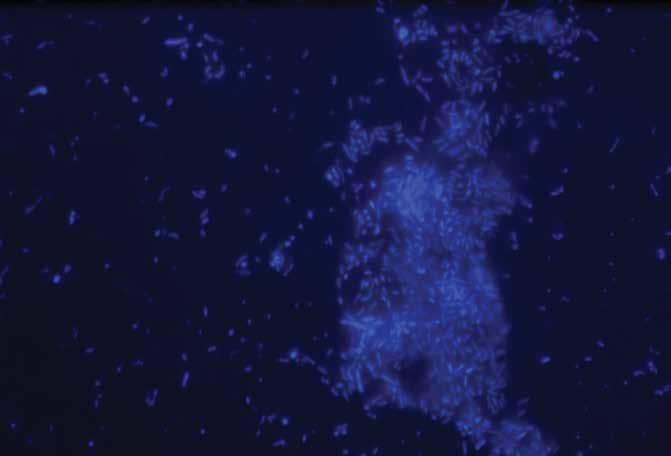
Future research directions
Since most marine microbes to date cannot be cultivated in the lab, scientists need ways to explore their functions without the benefit of laboratory cultures. DNA and RNA inventories of microbial communities tell us about the genes present and whether they are being used at the time of collection. These inventories are powerful tools for gaining a better understanding of metabolic pathways and the response of microbial communities to environmental conditions. Previous experience and the database amassed during Professor Taylor’s research, has enabled his team to make important steps towards developing techniques capable of linking key players to particular biogeochemical functions and activities of microbes. ‘We do so by allowing active members to incorporate stable isotopic tracers of a process and produce isotopically heavy biomass and we fluorescently-label subsamples with a selection of genetic probes. We then interrogate individual probe-positive cells in each taxonomic subsample by confocal Raman microspectrometry to determine extent of isotope incorporation. These single-cell analyses are performed in the NARMIL.’ Professor Taylor tells us. Among many other types of research, the lab enables scientists to determine which organisms dominate carbon, nitrogen and sulfur cycling in anoxic systems and to explore elemental cycling within anaerobic symbiotic associations.
Meet the researcher
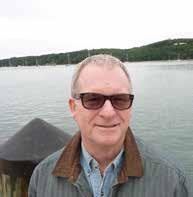
School of Marine and Atmospheric Sciences (SoMAS)
Stony Brook University
New York
USA
Professor Gordon Taylor at the Stony Brook School of Marine and Atmospheric Sciences has been researching oxygen depleted marine habitats for more than 23 years. After receiving his PhD from University of Southern California, Los Angeles in 1983, he has held several positions with both the University of Hawaii and Stony Brook University, where he became a full professor in 2005. In 2014, he founded the NAno-Raman Molecular Imaging Laboratory at Stony Brook through a National Science Foundation grant. There, he continues his research through his research project on ‘Genetic and Metabolic Signatures of Marine Microorganisms in Oxygen Depleted and Varying Geochemical Seascapes’.
CONTACT
E: gordon.taylor@stonybrook.edu
T: (+1) 631 632 8688
W: http://somas.stonybrook.edu/people/taylor.html
KEY COLLABORATORS
Professor Mary Scranton, School of Marine & Atmospheric Sciences, Stony Brook University
Dr VP Edgcomb, Geology and Geophysics Department, Woods Hole Oceanographic Institution
Dr MG Pachiadaki, Bigelow Laboratory for Ocean Sciences
Professor Frank Muller-Karger, College of Marine Sciences, University of South Florida
Professor Robert Thunell, Department of Earth and Ocean Sciences, University of South Carolina
Dr EA Suter, School of Marine & Atmospheric Sciences, Stony Brook University
FUNDING
NSF OCE-1335436 (V. P. Edgcomb, GT Taylor, C Taylor, co-PIs)
NSF OCE-1259110 (M Scranton, G Taylor, co-PIs)
NSF OCE-1336724 (G Taylor & D Knopf, co-PIs)
Gordon and Betty Moore Foundation, Grant #5064 (GT Taylor, PI; J Martínez Martínez & VP Edgcomb, collaborators)
REFERENCES
M Rodriguez-Mora, M Scranton, GT Taylor, A Chistoserdov, The dynamics of the bacterial diversity in the redox transition and anoxic zones of the Cariaco Basin assessed by massively parallel tag sequencing, FEMS Microbiol. Ecol., 2015, 91. doi: 10.1093/femsec/fiv088
MI Scranton, GT Taylor, R Thunell, C Benitez-Nelson, F Muller-Karger, K Fanning, L Lorenzoni, E Montes, R Varela, Y Astor, Interannual and decadal variability in the nutrient geochemistry of the Cariaco Basin, Oceanography, 2014, 27, 148–159.
GT Taylor, F Muller-Karger, RC Thunell, MI Scranton, Y Astor, R Varela, L Troccoli-Ghinaglia, L Lorenzoni, KA Fanning, S Hameed, O Doherty O, Ecosystem response to global climate change in the southern Caribbean Sea, Proc. Natl. Acad. Sci. USA, 2012, 109, 19315–19320.
V Edgcomb, W Orsi, J Bunge, SO Jeon, R Christen, C Leslin, M Holder, GT Taylor, P Suarez, R Varela, S Epstein S, Protistan microbial observatory in the Cariaco Basin, Caribbean. I. Pyrosequencing vs Sanger insights into species richness, J. Int. Soc. Microb. Ecol., 2011, 5, 1344–1356.
GT Taylor, MI Scranton, M Iabichella, T-Y Ho, RC Thunell, F Muller-Karger, R Varela, Chemoautotrophy in the redox transition zone of the Cariaco Basin: A significant midwater source of organic carbon production, Limnol. Oceanogr., 2001, 46, 148–163.

